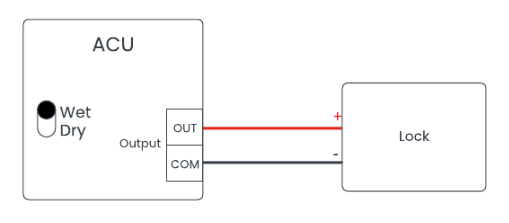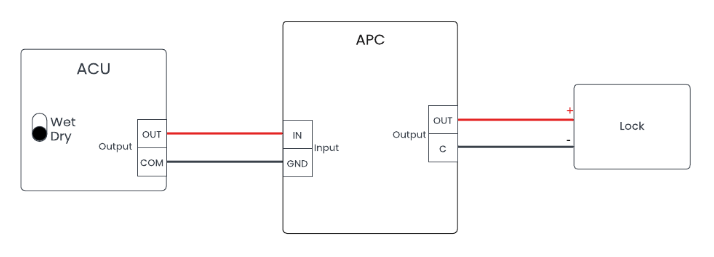By Derek Gunny, Solutions Engineer
In the context of access control, wet contacts are relay outputs that provide power, whereas dry contacts are relay outputs that do not provide power. A wet contact is typically used for access and power control of hardware along the same circuit, while a dry contact is often used for interfacing with other power control systems.
Background
Electronic door locks require a power supply to operate. The physical mechanisms that achieve the lock effect vary, but electronic door locks will use power to either engage or disengage the lock.
An access control unit (ACU) manages an electronic door lock by changing the circuit between the lock and its power supply. When the circuit between the lock and power supply is closed or continuous, the lock is powered. When this circuit is open or broken, the lock is unpowered. An ACU can trigger these changes in a lock’s power circuit continuity directly or indirectly.
Wet Lock Deployments
A lock can be controlled and powered directly by an ACU using wet contacts. Some ACUs are equipped to act as power supplies, and as such, they can power a variety of locks within their power specifications. In this case, the control circuit and power circuit are one and the same.

Dry Lock Deployments
To support locks that fall outside of an ACU’s power specifications, a separate piece of hardware can be employed known as an access power controller (APC). An APC will function as the power supply to the lock, but the circuit between the lock and the APC will be controlled by the ACU via dry contacts. Access control applications for dry contacts will typically consist of two circuits: a control circuit between the ACU and APC, and a power circuit between the lock and APC.

Frequently Asked Questions
When should I choose wet contacts or dry contacts for access control?
The choice between wet contacts and dry contacts depends on your specific access control needs. Wet contacts are suitable when you want to control and power the lock directly through the same circuit. Dry contacts are used when you need to interface with external power control systems or when the lock falls outside the ACU’s power specifications.
How does an access control unit (ACU) manage electronic door locks?
An access control unit (ACU) manages electronic door locks by controlling the circuit between the lock and its power supply. When the circuit is closed or continuous, the lock is powered, and when it is open or broken, the lock is unpowered. The ACU can trigger these changes in the lock’s power circuit continuity directly or indirectly.
What is the difference between wet contacts and dry contacts in access control?
In the context of access control, wet contacts refer to relay outputs that provide power, while dry contacts are relay outputs that do not provide power. Wet contacts are used for controlling and powering hardware along the same circuit, whereas dry contacts are typically used for interfacing with other power control systems.